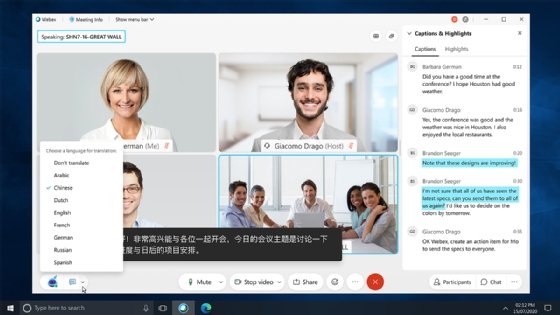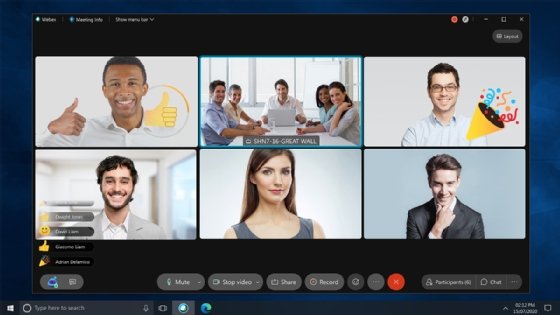
sepy - stock.adobe.com
Cisco overhauls Webex with slew of new features
Webex will soon provide calling, messaging and video in one user interface, live translation for multiple languages, and the ability to send emojis through hand gestures.
Over the next few months, Cisco will overhaul its unified communications platform Webex and release a bevy of new features meant to make the "new Webex" more competitive with rivals Microsoft and Zoom.
The features introduced this week at Cisco's inaugural WebexOne conference include live translations of 10 languages, turning hand gestures into emojis, and setting time limits for speakers during meetings. On top of that, Cisco consolidated messaging, video and calling into one user interface and launched an app marketplace.
Other Webex features announced at the conference include noise suppression, larger meeting limits and presenter overlays. All the enhancements represent an attempt by Cisco to surpass competitors.
"I think with these announcements, Cisco has put itself right back into the mix with Zoom and Microsoft in terms of AI," said Irwin Lazar, an analyst at Nemertes Research. "[Also, it] has arguably leapfrogged them in areas such as support for large-scale meetings, noise cancellation and ability to detect gestures."
Analysts said the AI-powered emoji feature is a novelty in the unified communications realm. Meeting participants can solicit a thumbs up emoji by showing a thumbs up or a clap emoji by clapping. They also can activate the raise hand function by raising their hands. The emojis are tabulated in the Webex chat function so hosts can see reactions.
"Gesture as an interface, as well as a communication mode, is becoming very interesting," IDC analyst Wayne Kurtzman said.

The nascent technology may evolve to serve a grander purpose, Kurtzman said. Cisco could use gestures to show how engaged participants are or to what degree they are paying attention to a meeting.
Jeetu Patel, general manager of Cisco's security and applications business group, said less technically savvy meeting participants will appreciate the hand-gesture feature. The capability also makes meetings more interactive.
To help hosts organize meetings, Cisco will add Webex templates that let organizers control who speaks and for how long.
For example, one template, called roundtable, will switch from one participant to the next after a designated amount of time, ensuring that all participants contribute to meetings uninterrupted. Another, called quick sync, sets a timer for meetings to force participants to be concise during five- or 10-minute sessions, Patel said.
Cisco's translation feature will allow participants speaking different languages to communicate over Webex without the need for an interpreter or transcriber. The languages included in the first iteration are English, Spanish, French, German, Mandarin, Portuguese, Arabic, Russian, Dutch and Japanese.
"We can be two different people in two different parts of the world speaking two different languages but communicate seamlessly with each other," Patel said.

Webex is not the first video conferencing application to have live translation and transcription. Microsoft Teams has had a similar feature since July. Zoom doesn't have a translation feature of its own, but third-party apps, such as spf.io, are available.
Cisco added several smaller Webex features. One lets meeting hosts overlay themselves over their presentations, much like a weather forecaster is superimposed over a weather map. Teams and Zoom already have the overlay feature.
Cisco expanded live streaming events in Webex from 3,000 to 100,000 people. The company also added a feature that transcribes and saves meetings into a searchable format.
On the partnership front, Cisco announced the creation of a Webex App Hub. The App Hub integrates apps like Box, Dropbox, Mural and Salesforce into Webex, making them available within the user interface. Zoom has a similar app marketplace, called Zapps. Microsoft has one for Teams.
Along with offering more third-party software within Webex, Cisco plans to introduce devices for the UC service. The upcoming hardware includes the Webex Desk, Webex Desk Camera and the Webex Desk Hub. These devices will roll out by summer 2021.
The Webex Desk, a cheaper version of the Webex Desk Pro, has a touchscreen monitor specifically designed for video conference meetings. The Desk Camera is a USB camera designed for home or office use. It comes with facial recognition and occupancy metrics.
The Desk Hub is a video phone designed for hot desking. Instead of being assigned a station, users place their phones on the Desk Hub, and it recognizes them and pulls up their data for the session.
"It makes the workflows very seamless," said Jon Arnold, principal at analyst firm J Arnold Associates. "They're trying to make it easier for people to come back to the office."
The Webex announcements come on the heels of two acquisitions Cisco made earlier in the week. Cisco acquired U.K.-based IMImobile to bolster its contact center and Bratislava, Slovakia-based Slido to add surveys to video conferencing. Cisco also touted its recent noise suppression acquisition, BabbleLabs, at WebexOne. The noise suppression technology is now available in Webex.
"That's what the all-new Webex is all about," said Javed Khan, general manager of Cisco's collaboration products. "Using our new investments and innovations to deliver virtual experiences that are 10 times better than in-person interactions and make connecting and collaborating more manageable and more accessible for everyone."








